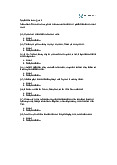



Preview text:
ENGLISH EUROLINK 1
LESSON 2: HOW TO THINK OF IDEAS FOR WRITING TASK 2 BY C HRISTOPHER PELL 7 COMMENTS
This post will help you think of better ideas for task 2 questions.
One of the biggest fears students have is opening up the writing paper, looking at task 2 and having no ideas.
Idea generation in IELTS writing task 2 is something students worry a lot about, but it doesn’t have to be that way.
SaveThe reason for this fear is natural, but there are easy solutions. First World Problems
Most of the students I teach come from developing countries and they often complain that IELTS writing part
two questions are biased towards ‘Western’ countries and are mostly ‘First world problems’. For example:
In some countries, young people are encouraged to work or travel for a year between finishing high
school and starting university studies. Discuss the advantages and disadvantages for young people who decide to do this.
‘What the hell is a ‘gap year?” shouted most of the learners in my class. I did have some sympathy for them
on this question. Most of the Vietnamese students I currently teach have no first hand experience with taking a
year off before going to University. This seems like a very ‘Western’ idea to them and they felt a little bit
annoyed with the question, which is totally understandable.
Fortunately, questions like these are rare and most of them will be on familiar topics that most people have an
opinion on, such as health, education and the environment. Remember that this is a language test not a general knowledge test.
Do my ideas have to be entertaining?
Many students also worry that their ideas are not interesting enough or they are too boring. The examiner
is not looking for you to entertain her. They are looking for you to demonstrate an ability to write an essay in
English supported by evidence and relevant examples. There are no extra points for interesting ideas. What
the ideas must be is relevant to the question being asked. Have a look at my post on question analysis for help with that.
You can have the most boring ideas in the world and still get a band score 9, as long as your ideas are relevant.
This may seem illogical to some people who have already been to university and know that your ideas should
be both relevant and interesting. Stop thinking about how you write at university level, this is an IELTS exam,
not a university essay. Give the IELTS examiners what they want and nothing else. Solutions ĐT: /
0987 673 932 facebook address: /
debigfan1987 fanpage: eur olink1987/ gr
oup : IEL TS FUN 7.0 ENGLISH EUROLINK 2
Below I will outline several solutions that have worked well for my students in the past. They are: 1. Common Topic Familiarisation 2.
Brainstorming (least effective) 3. Mind Mapping 4. 5 Questions Method 5.
Personal Opinion Method (most effective) No One Size Fits All
The main thing I have learned from teaching my students these methods is that no one method is suitable for
everyone. You have to try each of them out and see which one works for you. When you are practicing
remember, the examiner is looking for relevant ideas that you can support by explaining them and giving
examples. You should also use the one that gives you ideas quickly. You will only have 2 or 3 minutes for idea
generation in the exam. Don’t worry if this is taking you a lot of time at the moment, you will improve with
practice. Pick a method below, set yourself a time limit and practice with some old past exam papers. 1.
Common Topic Familiarisation
This simply means knowing the 10 common topics that come up in the exam and learning some vocabulary
associated with these repeated topics. The wider your vocabulary the easier it will be for you
to think of ideas. If you have time, don’t just stick with the 10 most common topics, go even further.
When you have free time, have a look at some English newspapers and identify some topics that might come
up in the IELTS test. When you do this you should be doing two things. The first is simply noting down any
unknown vocabulary, try to guess the meaning from the context and then look up the meaning to confirm on
your smart phone or dictionary. This will really help you, not only for writing part 2 but also for all the other parts of the IELTS exam. 0. Brainstorming
Brainstorming is basically thinking of as many ideas as possible relevant to your topic. It was developed by an
advertising agency, in order to come up with new ideas for advertising campaigns. The technique involves
putting keywords in the middle of a page and then writing down as many ideas associated with that idea as possible.
Some students, and many teachers, love this method and if it works for you then continue to use it, but I have
a few problems with it. Firstly, some students spend too much time on this stage and try to think of too many
ideas. Secondly, because they are thinking very generally, their ideas are not relevant. It then takes extra time,
which you don’t have in the exam, to sort out the relevant from the irrelevant ideas. 0. Mind Mapping
Mind mapping is a way to visually organise your thoughts on to paper.
Some people love this method, because it represents how their brain is working and allows them to organise
their thoughts. It is much more organised than simply brainstorming and can be done very quickly once you
have practiced a few times with different questions.
A good technique is to place the keywords in the middle and then place the micro-keywor ds on the branches.
The only disadvantage to this method is that some students spend too much time creating the perfect mind
map. There are no points for creating beautiful mind maps; they are only there to help you with ideas so do it quickly. ĐT: /
0987 673 932 facebook address: /
debigfan1987 fanpage: eurolink1987/ gr
oup : IEL TS FUN 7.0 ENGLISH EUROLINK 3 0. 5 Questions Method
This method uses who/what/why/where/how question words in order to generate ideas. This works best for
people who think very logically and also know a little bit about the topic already. Let’s look at an example:
In some countries, young people are encouraged to work or travel for a year between finishing high
school and starting university studies. Discuss the advantages and disadvantages for young people who decide to do this.
Why- to gain work experience, to experience life in different countries, to understand different cultures, to
make money before going to university, lazy, not mature.
Where- tourist destinations, developing countries, local business, internship in big company.
How- save money, permission from parents and university, apply for internship/job, travel to inexpensive countries.
So as you can see, in a couple of minutes we have generated many ideas by asking ourselves just three of
the five questions. These ideas are much more than we need to complete the task, so always remember to
choose the ones you feel comfortable writing about after you generate your ideas. 0.
Personal Opinion Method (or coffee shop method)
Personally, I think this is the most effective method because it is both the fastest and helps students focus on the question.
The method is simple. I ask students to imagine they are sitting with their friend or family member in a coffee
shop and they ask your opinion. In an exam there is a lot of pressure on you and you often find it difficult to
think, but if you were in a relaxed environment with a friend you would have no problem giving your opinion.
To think of more ideas you just imagine that your friend has the opposite feelings to you about the topic and write their ideas down.
Let’s look at the example below:
Your friend- ‘Do you think it’s a good idea that young people take a year off between school and university to work or travel?’
You- ‘Yes. Many young people are not mature enough to go to university at 18 and travelling or working will
help them mature. Working for a year could also allow them to save money and gain valuable work
experience. If they go travelling, they will get to experience different cultures.
So you see you have just thought about all the ideas you will need for this question. You can write your ideas
down (recommended) or just think about it for a minute.
This idea gives you a very clear idea about your opinion on the question and will help you stay relevant and
write a clear, coherent essay. Like any method it takes practice, so try it out with a few past questions. ĐT: /
0987 673 932 facebook address: /
debigfan1987 fanpage: eurolink1987/ gr
oup : IEL TS FUN 7.0 ENGLISH EUROLINK 4 ĐT: /
0987 673 932 facebook address: /
debigfan1987 fanpage: eurolink1987/ gr
oup : IEL TS FUN 7.0




